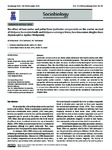Por favor, use este identificador para citar o enlazar este ítem:
http://www.alice.cnptia.embrapa.br/alice/handle/doc/1005962Registro completo de metadatos
| Campo DC | Valor | Lengua/Idioma |
|---|---|---|
| dc.contributor.author | QUEIROZ, A. C. M. | pt_BR |
| dc.contributor.author | CONTRERA, F. A. L. | pt_BR |
| dc.contributor.author | VENTURIERI, G. C. | pt_BR |
| dc.date.accessioned | 2015-01-19T11:11:11Z | pt_BR |
| dc.date.available | 2015-01-19T11:11:11Z | pt_BR |
| dc.date.created | 2015-01-19 | pt_BR |
| dc.date.issued | 2014 | pt_BR |
| dc.identifier.citation | Sociobiology, v. 61, n. 4, p. 536-540, Dec. 2014. | pt_BR |
| dc.identifier.uri | http://www.alice.cnptia.embrapa.br/alice/handle/doc/1005962 | pt_BR |
| dc.description | Spathodea campanulata is an African plant of African origin introduced in South America and other tropical and subtropical areas for ornamental purposes. This plant is related to insect mortality, bees included. However, its effects on the Neotropical Melipona are yet unknown. Thus, this study aimed to evaluate the effect of S. campanulata nectar and pollen on the survival of Melipona fasciculata and M. seminigra workers. A total of 120 newly emerged workers of each species were confined in boxes, without the presence of the queen, and divided in groups of 10 individuals. They were submitted to the following diets: S. campanulata nectar or 11% sucrose solution (nectar control); 11% sucrose solution and S. campanulata pollen or 11% sucrose solution and the species? original pollen (pollen control). The higher mortality of workers was detected on the experimental groups, with toxics nectar and pollen (M. fasciculata, p<0.01; M. seminigra, p<0.01) than on the respective controls. Our results point that nectar and pollen affected the survival of M. fasciculata and M. seminigra worker bees. Thus, S. campanulata is not a recommended plant to provide food resources for stingless bees. | pt_BR |
| dc.language.iso | eng | eng |
| dc.rights | openAccess | eng |
| dc.subject | Meliponicultura | pt_BR |
| dc.title | The effect of toxic nectar and pollen from Spathodea campanulata on the worker survival of Melipona fasciculata Smith and Melipona seminigra Friese, two Amazonian stingless bees (Hymenoptera: Apidae: Meliponini). | pt_BR |
| dc.type | Artigo de periódico | pt_BR |
| dc.date.updated | 2015-04-02T11:11:11Z | pt_BR |
| dc.subject.thesagro | Abelha | pt_BR |
| riaa.ainfo.id | 1005962 | pt_BR |
| riaa.ainfo.lastupdate | 2015-04-02 | pt_BR |
| dc.identifier.doi | 10.13102/sociobiology.v61i4.536-540 | pt_BR |
| dc.contributor.institution | ANA CAROLINA MARTINS DE QUEIROZ, CPATU; Felipe Andrés Leon Contrera, UFPA; GIORGIO CRISTINO VENTURIERI, CPATU. | pt_BR |
| Aparece en las colecciones: | Artigo em periódico indexado (CPATU)  | |
Ficheros en este ítem:
| Fichero | Descripción | Tamaño | Formato | |
|---|---|---|---|---|
| 52437801PB.pdf | 534,5 kB | Adobe PDF |  Visualizar/Abrir |









